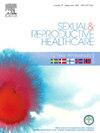避孕药引起的闭经:一项对南加州育龄城市人口认知的探索性研究
IF 1.7
3区 医学
Q3 PUBLIC, ENVIRONMENTAL & OCCUPATIONAL HEALTH
引用次数: 0
摘要
目的评价南加州以西班牙裔为主的育龄人群对避孕闭经的偏好和知识。方法本横断面研究从一家大型学术医院的三家门诊诊所招募有生育能力的英语和西班牙语受试者。一项有效的调查评估了人们对避孕药引起的闭经的偏好和认识。采用描述性统计、双变量分析(使用卡方检验)和多变量回归来评估人口统计学变量与避孕闭经意愿及其感知安全性之间的关系。结果209名受访者(回复率78.9%)中,西班牙裔占66.5%,基督徒占48.8%。大多数参与者(56.5%)不考虑会导致闭经的避孕方法。此外,大多数参与者(64.1%)认为避孕药引起的闭经是有害的。相信避孕药导致闭经的危害与避免可能导致闭经的避孕有关(p < 0.001)。然而,在统计上,对月经不满意的参与者更倾向于避孕闭经(p < 0.01)。种族与避孕闭经偏好(p = 0.89)或对其安全性的了解(p = 0.34)之间无显著关联。结论绝大多数妇女不赞成避孕闭经,担心闭经对健康有害。考虑到避孕引起的闭经的危害可能会限制所有种族高效避孕方法的使用,旨在审查安全性的教育倡议可能会让患者做出更明智的决定。本文章由计算机程序翻译,如有差异,请以英文原文为准。
Contraceptive-induced amenorrhea: An exploratory study of perceptions among a reproductive-age urban Southern California population
Objectives
To evaluate the preferences for and knowledge of contraceptive-induced amenorrhea among a reproductive age predominantly Hispanic community in Southern California.
Methods
This cross-sectional study recruited English and Spanish speaking reproductively capable participants from three outpatient clinics associated with a large academic hospital. A validated survey assessed preferences and knowledge surrounding contraceptive-induced amenorrhea. Descriptive statistics, bivariate analyses using chi-squared tests, and multivariate regression were performed to evaluate the association between demographic variables and the desire for contraceptive-induced amenorrhea, as well as its perceived safety.
Results
Of 209 respondents (response rate: 78.9 %), 66.5 % were Hispanic and 48.8 % identified as Christian. A majority of participants (56.5 %) would not consider a contraceptive method that would induce amenorrhea. Furthermore, a majority of participants (64.1 %) believed that contraceptive-induced amenorrhea is harmful. Belief of harm due to contraceptive-induced amenorrhea was associated with avoiding contraception that could induce amenorrhea (p < 0.001). However, participants who were discontent with menstruation statistically preferred contraceptive-induced amenorrhea (p < 0.01). No significant association was found between race and preference for contraceptive-induced amenorrhea (p = 0.89) or understanding of its safety (p = 0.34).
Conclusions
The majority of our sample would not prefer contraceptive-induced amenorrhea and feared that amenorrhea would be harmful. Given the perceived harm of contraceptive induced amenorrhea may limit the use of highly effective methods for all races, educational initiatives aimed at reviewing safety may allow for more informed patient decision-making.
求助全文
通过发布文献求助,成功后即可免费获取论文全文。
去求助
来源期刊

Sexual & Reproductive Healthcare
PUBLIC, ENVIRONMENTAL & OCCUPATIONAL HEALTH-
CiteScore
2.70
自引率
5.60%
发文量
73
审稿时长
45 days
 求助内容:
求助内容: 应助结果提醒方式:
应助结果提醒方式:


